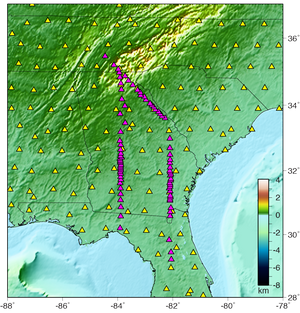 |
| Map of SESAME stations (magenta triangles) and EarthScope Transportable Array stations (yellow triangles) superimposed on topography. The SESAME stations are more closely spaced across the hypothesized location of the crustal suture in southern Georgia. |
The super-continent Gondwana attached to proto-North America at the culmination of the continental collision that built the Appalachian Mountains about 300 million years ago. Based on variations in fossils, rock types and ages, and a zone of southward dipping reflectors imaged by seismic reflection data, the juncture between these two continents is thought to lie in the crust beneath southern Georgia. Subsequently, this region was rifted during the opening of the Atlantic Ocean, depositing large volumes of magma into the crust.
The goal of the SESAME project is to better understand how the continental lithosphere was accreted and deformed during collision and how rifting and formation of the current Atlantic passive margin later modified it. To investigate these fundamental questions, 85 EarthScope Flexible Array stations were deployed in two north-to-south lines that cross the suture zone. A third line is oriented roughly normal to Appalachian crustal terranes in northern Georgia (see map). These seismic stations, together with the stations of the EarthScope Transportable Array, are recording seismic waves from earthquakes around the globe. The data will be analyzed in a variety of ways to develop a model for the three-dimensional structure of the crust and upper mantle beneath this complex region.
 |
 |
| Scientists install a SESAME seismic station in Georgia. | Principal Investigator Lara Wagner (University of North Carolina, Chapel Hill) checks data recorded at a SESAME seismic station in Georgia. |
Principal Investigators and Institutions:
Karen Fischer (Brown University)
Don Forsyth (Brown University)
Rob Hawman (University of Georgia)
Lara Wagner (University of North Carolina-Chapel Hill)
Field Dates:
July 2010 - June 2014 (in progress)
Funding Source:
National Science Foundation Earth Sciences - EarthScope (American Recovery and Reinvestment Act of 2009): SESAME Award